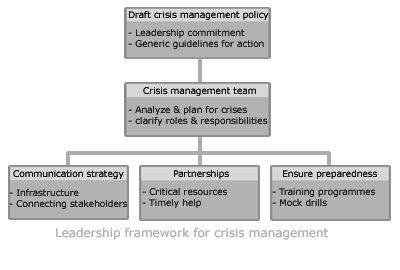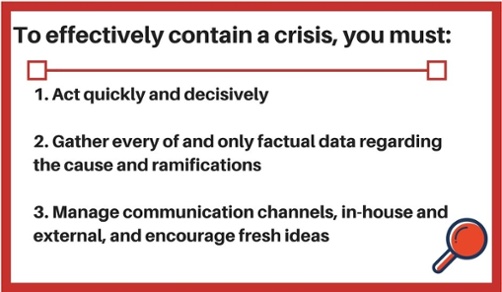Every project manager dreads the moment when deadlines are missed, budgets spiral out of control, or unexpected challenges throw a project off course. While crises are inevitable, how you respond to them makes all the difference.
Crisis.
Nothing strikes fear into the heart of a project manager than being informed that a deadline has been missed, the project is over budget, and simultaneously each of your team leaders all are sick at home with the flu. That example is hyperbolic, but according to the infallible Murphy‘s law, what can go wrong will go wrong, and stranger things than that example have happened in the past. Trust us.
Before you became a project manager, it is likely that as a lower-level employee in an organization you have previously experienced a project crisis, and been witness to your manager freaking out, pulling out their hair, and lashing out at employees. If you haven‘t, count yourself lucky. It‘s not only unpleasant but counterproductive to solving the situation at hand.
Any seasoned project manager will have experienced their fair share of crises in the past and hopefully has adopted measures and practices to handle hardships and extreme challenges to project performance. However, if you are green when it comes to crisis management as a project manager, lend us your ear and we will bring you up to speed with how the pros handle it.
Crises come in all shapes and sizes, whether financial, technological, or public relations. Whatever you are dealing with, there are steps to take before and during a crisis to prevent or mitigate the damage a crisis causes to your project.
A. Prior to crisis
1. Crisis prevention
The first, and most vital step in crisis management is actually managing the crisis before you need to manage it (we love those meta moments). What better way to handle a problem than preventing it from happening in the first place?
We are not saying that you need to be a psychic, but pay attention to early warning signs of impending doom. Consider how Pacific coast countries detect whether a tsunami is going to happen or not. They do not simply have a person on the beach perched up in the air with a pair of binoculars, ready to shout “Tsunami!” when they see one approaching.
What tsunami-prone countries do have is a series of monitoring devices in place, such as deep-sea buoys far from the coast, to indicate when a tsunami is approaching.
The same principle should be applied to your crisis management. Monitor every aspect of your project at all times. We don‘t advocate that you be a pessimist but do expect the worst to happen. You will live in a sea of relief at the end of each day when the crisis has been averted.
To be honest, if you are new to project management you are not always going to know what to look for, or what to be monitoring to avoid crises. Take advantage of the following resources if you‘re still new to your role:
1. Insights from previous project managers
2. Research how successful executives have managed crises in the past
3. Study how well or poorly your competition handles crises
4. News pertinent to your industry
5. Public opinion shifts in perception; social media trends, rumors, etc.
2. Develop detailed contingency plans with a crisis management team

It is rather unlikely that you will come up with a series of comprehensive contingencies on your lonesome. In addition to informing all of your staff about your crisis management planning and training them on protocols, assign a dedicated crisis management team. Depending on the scope of your organization, it can be anywhere from two people to 20.
The smartest project managers assign at least one person, either department heads or management staff, per each department to be trained and accountable for mitigating the effects of crises in their respective sectors. These should include at the very least, in addition to the CEO, heads of:
-
HR -
Sales -
Marketing -
IT -
PR
Each department representative should be abreast of exactly what could possibly go wrong in their respective departments. Collaborate and develop contingencies together with each of them. Make certain that each member of your team is educated on the risks and contingencies in place for each other‘s departments. The more every member of your team knows, the better you will work together to solve crises.
As a manager, you may feel responsible for handling matters on your own, but face it, the best managers know when to ask for help. If you assemble your team as soon as you take the management reigns, not only will you be better prepared for when crisis strikes, but your colleagues will be impressed with your proactivity and early management acumen.
B. During crisis
3. Keep a cool head and be optimistic
In the face of disaster, as the project manager, you lead the ship. Your team and colleagues are going to be looking to you for guidance and moral support. Lead by example. If your team sees that you are concerned, focused, yet calm and collected, they will mimic your demeanor.
Panic does nobody any good, and exacerbates an already tumultuous time. If you lose your cool, so will your team. If you keep your cool, each person will do their part to solve the dilemma.
If you are optimistic that you will pass through this trying time intact, your team will feel motivated to work hard at resolving that which is plaguing your organization. By no means give anyone false hope, but optimism is contagious, and motivates your team.
4. Contain the crisis
The first practical step to take after a crisis strikes is to stop it from spreading any further. At this point, you cannot prevent it any longer, but you can control it, and then take measures to eradicate it. To effectively contain a crisis, you must:
1. Act quickly and decisively
2. Gather every of and only factual data regarding the cause and ramifications
3. Manage communication channels, in-house and external, and encourage fresh ideas
Once you have all of the facts and are in control of communication, then you can move forward with problem-solving in the midst of a crisis.

5. Identify the cause
Once you have prevented the crisis from spreading further than it already has, you can take the steps to repair the damage done and get your team back on track. The first step to take in identifying the cause of your crisis is to locate the department in which the root problem surfaced.
Next, meet with your department head and their team and take a thorough inventory of the degree to which each member was responsible, or not, for the root cause. Don‘t just single out team members that made a mistake. Review the facts, and hold a brainstorming session with the whole team, discussing how to best prevent this crisis from repeating itself.
In the worst-case scenario
Find the crisis silver lining
Just because you‘ve weathered a crisis and are back on track does not mean that your job as project manager is done. In fact, there is still work to do. Remember how we started off with the importance of monitoring? After surviving the crisis, make certain that you have cataloged not only how the crisis began, but the steps that were effective in solving it.
After you‘ve survived a few crises, and have thoroughly kept records of your crisis management, you will not only do a better job at monitoring and preventing, but the next time a crisis rears its ugly head you will be prepared with the tools to solve it in the most expedient manner possible. Do not welcome crisis, but take advantage of the one benefit it does offer you: experience.



